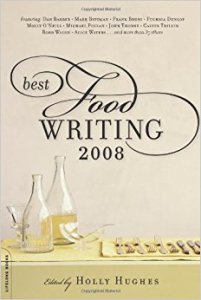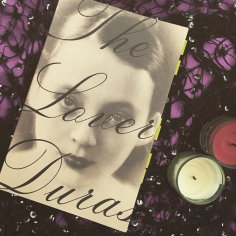Best Food Writing 2008
Edited by Molly Hughes
 It’s a good thing, I suppose, that books about food don’t come with a sell-by date. If they did I’d ignore it in the case of this volume .
It’s a good thing, I suppose, that books about food don’t come with a sell-by date. If they did I’d ignore it in the case of this volume .
I’ve admitted I’m a sucker for annuals. Sports. Science. Music. They’re one of the great cheats in my reading life. So when this food annual showed up in the discount bin for a buck I gladly added it to my shelf.
It might be one the best dollars I’ve ever spent and not just because of the recipes.
Much as I hate to admit it, the heavy stuff sometimes becomes too heavy. I have a few ways of lightening things up and reading books about food is one of them. That includes cookbooks, which I have been instructed to stop purchasing even though there’s a better than even chance something new will end up on the table.
So any book with some recipes presents a nice end run around Mrs. AHC.
What, exactly, should we make of such a book? I can’t help thinking its very existence speaks to the tenor of our times. After all, it’s been a while now since we identified fancy kitchens, cooking shows and ever more exotic foodstuffs as being emblematic of a certain strata of consumer rather than about food.

Survey says: if you can afford a kitchen like this you cook less frequently than people making a fraction of your income.
In a way, this book dovetails exactly with such a set of circumstances. Take the author list as just one example. For everyone you never heard of–and there are some very good writers here who I, for one, have never encountered before–there’s at least one name from the celebrity food culture. Dan Barber. Michael Pollan. Mark Bittman. And that’s just the guys.
I am not complaining about those people. They honestly care deeply about food even as they are part of a machine. It’s hard to escape such pressures in a commercial society. It’s a system in which Alice Waters (also here) has a cookbook franchise and Thomas Keller impossibly operates restaurants intended to be the ne plus ultra of gastronomy on opposite coasts.
Even some of the authors are aware of this. Perhaps the best example is Jess Thomson‘s detailed delineation of the dégustation at Chicago‘s Alinea. She’s just irreverent enough to poke fun at the conceits the food comes wrapped in–and there’s a lot of fancy presentation here, this being a 10-course tasting menu at a stratospheric price point.

If you recognize this room you can afford the kitchen above (and probably rarely use it).
As important, she’s fair to the food by which I mean when it is good, or very, very good she says so while not being afraid to note that which is horrid. Too often, I find, people are afraid to say anything negative about a restaurant, especially in a temple to Mammon–all tarted up, pretending to be only about la belle cuisine and the joys of an epicurean lifestyle.
There are a number of pieces about New Orleans which worked well for a couple of reasons. Primarily that’s because I believe the Big Easy is really the only North American city with a food culture outside Montreal. Other cities have restaurant scenes, in New Orleans the song says it best: “I may not be good lookin’, but I sure can cook.’
Most of these pieces were published in 2007 and so they are focused on the city after the disaster of Katrina. As luck would have it, I found myself in NOLA three times between 2007 and 2008 and so had my own memories of the period. Mostly, I think the stories captured the determination of so many people to not lose what’s unique about the country’s most different city.
Two pieces–from writers living at opposite ends of the economic spectrum–stood out for me. The name Thomas O. Ryder may be better known in the corridors of publishing and finance since he was a high-level executive at American Express before becoming the CEO of Reader’s Digest. He is also a Louisiana native.

Pork is love.
Here he returns to his roots, eating at one of the city’s then newest eateries–Donald Link‘s Cochon–and then undertaking a short tour of authentic joints out in the country recommended by Link. Make no mistake, these are joints and I found myself mentally flipping between a polished executive elbows-deep in hot sauce and a good ole’ boy in the corridors of power.
I also hadn’t realized that Link only opened Cochon in 2007. I stumbled upon it that year and have since found reason to visit it countless times. Pork is love and Cochon is pork. If you don’t have objections to eating pork there’s no better place to do it than here.
On the opposite end of the spectrum there’s a piece from Sara Roahen, a professional cook and writer, that is an homage to her adopted city’s signature dish: red beans and rice. At the center of the story is Pableaux Johnson, a serious extrovert with a Francofied moniker, who’s never reluctant to invite people over on a Monday evening for a plate of beans. Better than almost any other piece I thought this one captured food as culture, intermixed so completely with people and place as to be inseparable, like nitrogen and oxygen in air.

You can find anything on the Internet. Pableaux Johnson’s red beans and rice.
Best of all, there was a recipe that I have every intention of attempting once we get back to cooler temperatures.
There’s more here to delight. Biscuits as a way of life. Butter as friend not enemy. Noodle vendors in Shanghai. Memories of childhood trips to various Chinatowns sharpening after a visit to China. Tales of different restaurants being built, rebuilt and shuttered. And more than one story of meat recidivism by vegetarians that seem to have struck some commentators as mean.
Mostly there’s no better way to take a break and recharge your brain. I have too much downtime and accomplish too little these days. It’s good to know that my own desire, maybe need, to build a food-based culture, even if it’s in just one small home, can still be kindled.
Bottom line, if you come across this book somewhere grab it and dig in.
Advertisements Share this:





